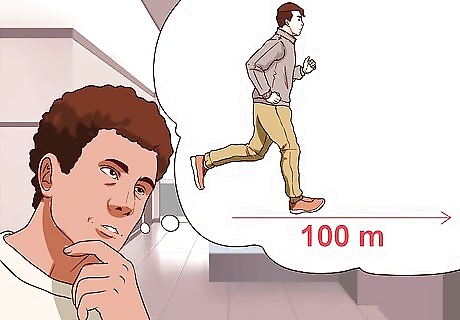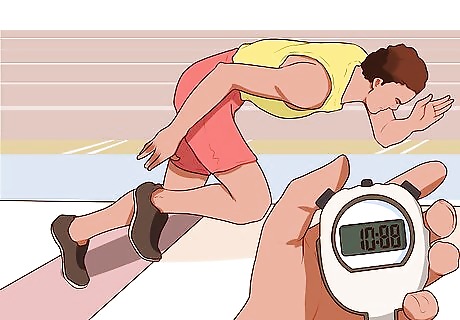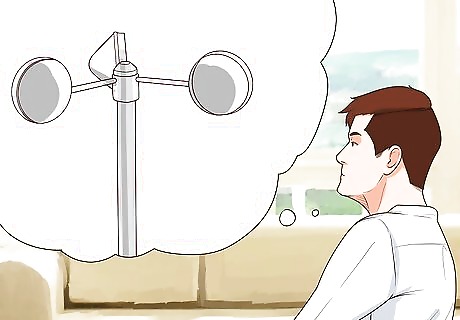
views
Measuring a Runner's Speed

Determine the distance the runner is to run. This can be done on a running track of a known length, such as 100 m (328 ft), or by staking out the distance on an open field. Use a measuring tape or a meter stick to measure the distance if you’re in a field. Mark the starting and ending points with a piece of string or a cone.

Set-up the experiment. In order to determine the runner’s speed you need to know the amount of time it takes the runner to travel the set distance. Tell the runner to wait until you say “Go!” to get an accurate reading on the stopwatch. Make sure your stopwatch is set to zero, then have the runner get in position at the start of the measured distance. You can also use a watch to time the runner, but it will be less accurate.

Start the runner and your watch at the same time. To sync up the timing as best as possible, yell “Go!” and start the watch at the same time. If you realize that the timing was off, have the runner reset and try again.

Stop your watch when the runner crosses the finish line. Watch closely to see when the runner crosses the point designated as the finish line. Be sure to stop the watch as close to the exact moment he crosses as possible.

Divide the distance the runner traveled by the number of seconds elapsed. This division is the calculation to determine the runner’s speed. The equation for speed is distance traveled/time to travel that distance. Using the example length of 100 m (328 ft), if the runner took 10 seconds to run that distance, the runner's speed would be 100 m (328 ft) divided by 10, or 10 m/sec (32.8 feet per second). Multiplying 10 m/sec by 3,600 (the number of seconds in an hour), the runner traveled 36,000 meters per hour, or 36 kilometers per hour (1 kilometer equals 1,000 m). Multiplying 32.8 feet per second by 3,600, the runner traveled 118,080 feet per hour, or 22.4 miles per hour (5,280 feet equals 1 mile).
Measuring the Speed of Sound

Find a wall that reflects sound. A large brick or concrete wall will work well for this experiment. You can test the wall by clapping your hands or yelling and listening for an echo. If you hear a strong echo, it’s a good wall to use.

Measure a distance of at least 50 m (54.5 yards) from the wall. A 50 m (54.5 yd) distance is suggested because it should give you enough time to make accurate measurements. Because you are taking into account the distance the sound will travel from you to the wall and back to you, you are actually measuring a distance of 100 m (109 yd). Measure the distance with a tape measure. Try to be as accurate as possible with your measurements.

Clap your hands in time to the echo from the wall. Stand in front of the wall at the measured distance and clap your hands slowly. You should be able to hear the echo as you do it. Speed up or slow down your clapping rhythm until your clap coincides with the echo from the previous clap. If you are perfectly in sync, you shouldn't hear the echo, just your clap.

Clap your hands 11 times while recording time with the stopwatch. Have your friend start the watch on the first clap and stop on the last clap. By clapping 11 times you will have timed 10 distance intervals for the sound of the clap to reverberate off the wall. In essence, the sound has traveled 10 times the initial 100 m distance. Clapping 11 times also gives your friend enough time to start and stop the watch accurately. Perform this step multiple times and average the times together to get a more accurate measurement. To average the trials, add up all the times and divide by the number of trials.

Multiply the distance by 10. Because you clapped 11 times, the sound actually traveled 10 times the distance. 100 meters multiplied by 10 is 1000 meters.

Divide the distance the sound traveled by the amount of time it took to clap. This will measure the speed of the sound of the clap from your hands to the wall and back to your ears. For example, let’s say it took 2.89 seconds for the 11 claps. To find speed we take the distance, 1000 meters, and divide by the time, 2.89 seconds to get a speed of sound of 346 m/sec. The speed of sound at sea level is 340.29 m/sec (1,116 feet per second or 761.2 mph). Your calculations should come close to this figure, but may not match it exactly, especially if you aren’t at sea level. At higher altitudes, the air gets thinner and the speed of sound is slower. Sound travels faster through liquids and solids than it does through air because sounds moves more quickly through materials of higher density.
Measuring Wind Speed

Obtain an anemometer. An anemometer is a device that measures wind speed. It consists of 3 or 4 cups mounted on wires attached to a central rotating shaft. Wind catches the cups and makes them spin. The faster the wind blows, the faster the cups spin around their axis. You can either buy an anemometer or make your own. To make your own, get five three-ounce paper cups, two straws, a sharpened pencil with an eraser, a stapler, a small sharp pin, and a ruler. Color the sides of one of the cups to make it distinct from the others. Punch a hole in the side of four of the cups about 1 inch from the rim. In the fifth cup, punch four holes equally spaced around the cup about 1 inch from the rim. Also, punch one hole in the bottom of this cup. Push one straw through the side of one of the cups leaving about 1 inch of straw inside the cup. Staple the straw to the side of the cup. Feed the rest of the straw through the fifth cup with 4 holes in one side and out the other. Place a second cup on the end of this straw and staple it in place. Make sure all of the cups face the same direction. Repeat the above step with the other two cups, feeding the straw through the remaining two holes in the middle cup. Again, make sure all cups are facing the same direction. Carefully, place a pin through the intersection point of the straws in the middle cup. Feed the pencil through the bottom hole of the fifth cup and push the pin through the eraser. Make sure your anemometer can spin freely. If so, it is now ready to use. If not, adjust the pencil so the eraser is not directly up against the straws.

Calculate the circumference of the anemometer. When one of the cups completes a full rotation, the distance it travels is the circumference of the circle. To calculate the circumference you need to measure the diameter of the circle. Measure the distance from the center of the anemometer to the center of one of the cups. This is the radius of the anemometer. Doubling this distance is the diameter. The circumference of a circle is equal to the diameter times the constant pi or 2 times the radius times pi. For example, if the distance between the center of the cup and the center of the anemometer is 30 cm (1 foot), the distance the cup travels in a single rotation is 2 x 30 x 3.14 (rounding pi to 2 decimal places), or 188.4 cm (74.2 inches).

Place the anemometer where the wind will catch its cups. You want enough wind to spin the anemometer, but not blow it over. You may need to anchor it to the ground or a post to keep it upright.

Count the number of times the anemometer spins for a fixed length of time. Stand at a fixed point and count the number of times the colored cup rotates around the circle. Possible intervals are 5, 10, 15, 20, 30 seconds, or even a full minute. Set a timer to go off at your specific time interval to ensure accuracy in the count. If you don’t have a timer, have a friend watch the clock, while you count the rotations. If you purchased an anemometer, mark one of the cups in some way to allow you count properly.

Multiply the number of rotations by the distance the anemometer travels in a single rotation. This will give you the total distance the anemometer traveled in the time you were watching it. For example, your anemometer has a radius of 30 cm (.98 ft), therefore it travels 188.4 cm (6.18 ft) in a single rotation. If it rotated 50 times during your count, then the total distance is 50 x 188.4 = 9420 cm.

Divide the total distance over the elapsed time. The equation for speed is total distance divided by the amount of time it takes to travel that distance. Taking the total distance the anemometer spun and dividing it by the amount of time you counted for will give you the current wind speed. For example, if you counted the number of rotations in 10 seconds you would divide the distance traveled by 10 seconds. Speed = (9420 cm/10 sec) = 942 cm/sec (30.9 ft/sec). Multiplying 942 cm/sec by 3600 gives 3,391,200 cm/hr, divided by 100,000 (the number of centimeters in a kilometer) or 33.9 km/hr. Multiplying 30.9 feet per second by 3,600 gives 111,240 feet per hour, divided by 5,280 gives 21.1 miles per hour.




















Comments
0 comment